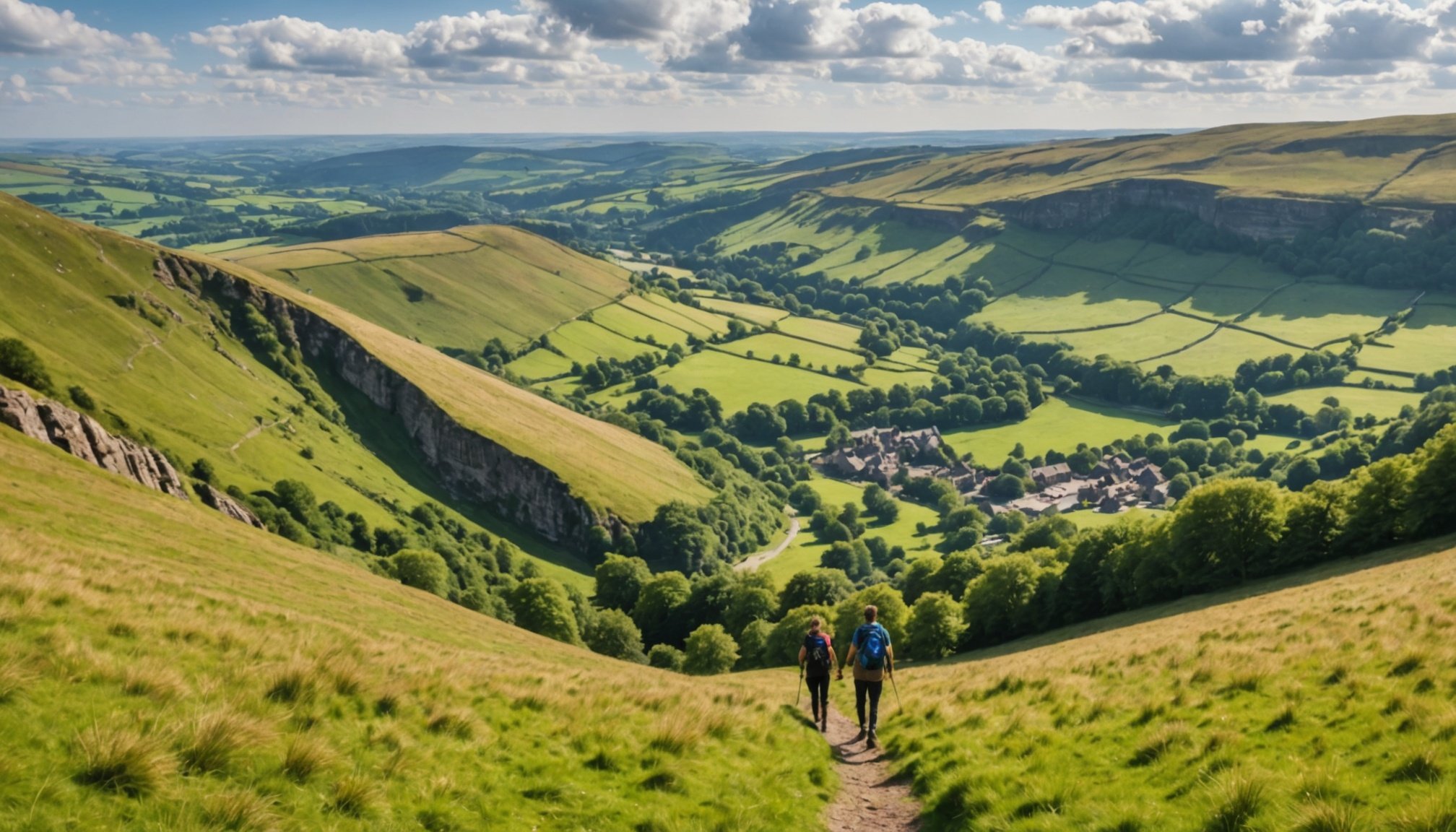Ultimate Guide to Planning an Eco-Friendly Hiking Experience in the Peak District
Why Choose the Peak District for Your Hiking Adventure?
The Peak District National Park, located in Derbyshire, is one of the most stunning and diverse hiking destinations in the UK. With its rolling hills, picturesque valleys, and rugged moorlands, it offers a wide range of hiking trails suitable for all levels of experience. Whether you’re a seasoned hiker or just starting out, the Peak District is an ideal place to embark on an eco-friendly hiking adventure.
Planning Your Eco-Friendly Hike
Choosing the Right Trail
The Peak District boasts numerous trails, each with its unique characteristics and challenges. Here are a few popular and eco-friendly options:
Additional reading : Eco-Conscious Hiking Tips for an Unforgettable Adventure in the Stunning Peak District
- Mam Tor Circular Walk: This 4.1km circular walk is a great option for families and those looking for a shorter, yet rewarding hike. It offers spectacular views from the top of Mam Tor and a scenic route along Great Ridge and Broken Road[1].
- Padley Gorge and Longshaw Estate Walk: This 2.7km circular walk is perfect for families with young children. It includes paddling in streams, climbing boulders, and exploring the National Trust’s Longshaw Estate[1].
- Edale Skyline Hike: For the more adventurous, the Edale Skyline Hike is a 20-mile challenge that takes you around the surrounding hills of Edale village. This hike is best attempted in warmer months with more daylight hours[4].
Preparing Your Gear
To ensure an eco-friendly hiking experience, it’s crucial to choose the right gear:
- Hiking Boots: Opt for durable, waterproof hiking boots that can withstand various terrain conditions. Consider purchasing boots made from sustainable materials.
- Clothing: Wear layers of breathable, moisture-wicking clothing. Choose items made from eco-friendly fabrics like merino wool or recycled materials.
- Backpack: Select a lightweight, durable backpack with multiple compartments to keep your gear organized. Look for brands that use sustainable materials and production methods.
- Water Bottle: Bring a refillable water bottle to reduce plastic waste. There are several water refill points throughout the Peak District.
Packing Essentials
Here’s a detailed list of what you should pack for an eco-friendly hiking trip in the Peak District:
In the same genre : Unveiling birmingham”s best-kept secrets: a comprehensive guide to local markets featuring artisanal crafts
- Navigation Tools: A map, compass, and GPS device or app.
- First Aid Kit: Including essentials like bandages, antiseptic wipes, pain relievers, and any personal medications.
- Food and Water: Pack energy-rich snacks, sandwiches, and a refillable water bottle. Opt for locally sourced and organic food to reduce your environmental impact.
- Clothing and Footwear: Extra socks, a change of clothes, and a waterproof jacket.
- Sunscreen and Insect Repellent: Choose eco-friendly brands that are free from harmful chemicals.
- Trash Bag: To collect any trash you might encounter on the trail and leave the area as you found it.
- Headlamp or Torch: In case you’re hiking late in the day.
Minimizing Your Environmental Impact
Leave No Trace Principles
Adhering to the Leave No Trace principles is crucial for maintaining the natural beauty of the Peak District:
- Plan Ahead and Prepare: Research your trail, check the weather, and prepare your gear to avoid any unnecessary impact.
- Travel and Camp on Durable Surfaces: Stick to designated trails and avoid damaging vegetation.
- Dispose of Waste Properly: Carry all trash with you and dispose of it in designated bins.
- Leave What You Find: Do not disturb or remove any plants, rocks, or other natural features.
- Minimize Campfire Impacts: Avoid using campfires unless absolutely necessary, and use a portable stove instead.
- Respect Wildlife: Keep a safe distance from wildlife and do not feed them.
- Be Considerate of Other Visitors: Respect other hikers, cyclists, and local residents.
Eco-Conscious Accommodations
For multi-day hikes, choosing eco-conscious accommodations can significantly reduce your environmental footprint:
| Accommodation Type | Location | Eco-Friendly Features |
|---|---|---|
| YHA Castleton | Castleton | Solar panels, rainwater harvesting, locally sourced food |
| The Old Nags Head | Edale | Energy-efficient lighting, recycling program, local suppliers |
| The Anglers Rest | Bamford | Sustainable building materials, energy-efficient heating |
These accommodations not only provide comfortable stays but also contribute to the conservation of the Peak District’s natural environment.
Navigating the Trails
Using Maps and Compasses
While many hikers rely on GPS devices, learning to use a map and compass is an essential skill for any hiker. Here are some tips:
- Understand Map Symbols: Familiarize yourself with the symbols and markings on your map.
- Orient Your Map: Use your compass to align your map with the surrounding landscape.
- Take Bearings: Use your compass to determine the direction you need to go.
- Pace Counting: Measure your distance by counting your paces to estimate how far you’ve traveled.
Peak District Walks offers guided walks with an introduction to map reading, which can be a great way to learn these skills in a practical setting[4].
Popular Trails and Their Characteristics
Here is a comparison of some popular trails in the Peak District, highlighting their unique features and challenges:
| Trail Name | Distance | Elevation Gain | Time | Difficulty | Features |
|---|---|---|---|---|---|
| Mam Tor Circular | 4.1 km | 200 m | 2 hours | Easy | Great Ridge, Broken Road, spectacular views from Mam Tor |
| Padley Gorge and Longshaw Estate | 2.7 km | 100 m | 3 hours | Easy | Paddling in streams, climbing boulders, National Trust’s Longshaw Estate |
| Edale Skyline Hike | 32 km | 1000 m | 8-10 hours | Challenging | Surrounding hills of Edale village, diverse landscapes |
| Bamford Edge Circular | 7.9 km | 300 m | 4 hours | Moderate | Ladybower Reservoir, wood carvings, Bamford stepping stones |
| Kinder Scout and Mam Tor Circular | 19.3 km | 700 m | 6-8 hours | Challenging | Kinder Reservoir, Kinder Downfall, diverse moorland views |
Each trail offers a unique experience, so choose one that aligns with your fitness level and interests[1][3].
Local Tips and Insights
Parking and Transportation
- Car Parks: Use designated car parks such as the Mam Tor National Trust car park or the Dovedale car park. Be aware that some car parks may require cash payments[1].
- Public Transportation: The Peak District is well-connected by public transportation. Use buses or trains to reach your starting point, reducing the need for personal vehicles.
Local Amenities
- Food and Drink: Support local businesses by eating at cafes and pubs that source their ingredients locally. The Anglers Rest in Bamford is a great example, offering a pub, cafe, and post office all in one[1].
- Ice Cream and Snacks: Don’t forget to enjoy local treats like ice cream from the van at Longshaw Estate, which only accepts cash[1].
Planning an eco-friendly hiking experience in the Peak District is not only rewarding but also crucial for preserving this beautiful national park. By choosing the right trails, preparing eco-friendly gear, minimizing your environmental impact, and using local amenities, you can ensure a great adventure while leaving a positive footprint.
As Becky from Peak District Walks advises, “The key to an eco-friendly hike is preparation and respect for the environment. Always leave the area as you found it, and support local communities to ensure the sustainability of these beautiful trails.”
Whether you’re embarking on a short family walk or a multi-day hike, the Peak District offers something for everyone. So pack your bags, grab your hiking boots, and get ready for an unforgettable eco-friendly hiking experience in one of the UK’s most stunning national parks.










